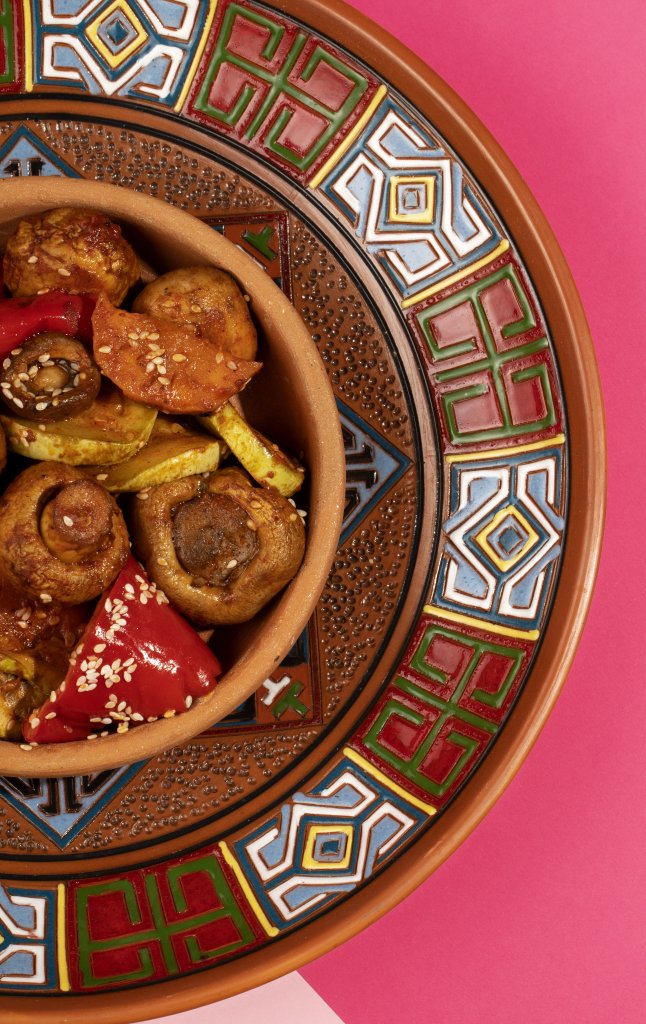Discover the vibrant world of the Moroccan food menu, a delightful blend of history, culture, and exquisite flavors. From iconic tagines to aromatic spices, prepare for a culinary adventure that tantalizes the taste buds. Let’s explore the essential dishes that define the morocco food menu and the flavors of the morocco menu.
Living into the Heart of the Moroccan Dinner Menu
Imagine sitting down to a traditional Moroccan dinner menu. What culinary treasures might grace your table? Here are some quintessential dishes that paint a vivid picture of Moroccan gastronomy:
- Tagine: is an iconic Moroccan dish, named after the earthenware pot in which it’s slow-cooked. As a cornerstone of the cuisine, it comes in countless variations. Popular choices include the sweet and savory lamb tagine with prunes and almonds, the tangy chicken tagine with preserved lemons and olives, and many flavorful vegetarian options that showcase the country’s fresh produce.
- Example: Imagine tender pieces of lamb slowly braised with aromatic spices like ginger, cumin, and turmeric, the sweetness of dates or prunes adding a luxurious touch, all garnished with crunchy almonds.
- Example: Imagine tender pieces of lamb slowly braised with aromatic spices like ginger, cumin, and turmeric, the sweetness of dates or prunes adding a luxurious touch, all garnished with crunchy almonds.
- Couscous: Often served as a centerpiece for communal meals, especially on Fridays, couscous consists of fine semolina grains steamed to fluffy perfection and typically accompanied by a flavorful stew of meat (often lamb or beef) and vegetables like carrots, zucchini, and turnips.
- Example: Picture a generous mound of light and airy couscous soaking up the rich flavors of a saffron-infused broth, studded with tender chunks of meat and colorful vegetables.
- Example: Picture a generous mound of light and airy couscous soaking up the rich flavors of a saffron-infused broth, studded with tender chunks of meat and colorful vegetables.
- Pastilla: This visually stunning and incredibly flavorful savory pastry is a true celebration of Moroccan culinary artistry. Traditionally made with pigeon (though chicken is a common alternative), saffron-infused eggs, and almonds, all encased in delicate layers of waraqa pastry (similar to phyllo), and dusted with powdered sugar and cinnamon. The sweet and savory combination is an explosion of taste and texture.
- Example: Envision flaky layers of pastry giving way to a savory filling of shredded chicken, aromatic spices, and a subtle sweetness from the almonds and sugar.
- Example: Envision flaky layers of pastry giving way to a savory filling of shredded chicken, aromatic spices, and a subtle sweetness from the almonds and sugar.
- Harira, a hearty and flavorful soup, is a staple in Morocco, especially during Ramadan. It’s a rich blend of tomatoes, lentils, chickpeas, and lamb or beef, often seasoned with fragrant herbs and spices. A squeeze of lemon adds a bright finish.
- Example: Think of a comforting and nourishing soup, packed with wholesome ingredients and the warm embrace of cinnamon and ginger.
Exploring the Rich Flavors of Morocco Menu
The flavors of the Morocco menu are characterized by a masterful use of spices. You’ll encounter fragrant blends like ras el hanout, a complex mix that can contain dozens of different spices, as well as individual spices like cumin, turmeric, ginger, cinnamon, saffron, and paprika, each contributing its unique note to the overall harmony of the dish.
Beyond spices, the Moroccan palate embraces the sweetness of dried fruits like dates, figs, and apricots, the tanginess of preserved lemons and olives, and the freshness of mint, cilantro, and parsley. Argan oil, a nutty and distinctive oil produced from the kernels of the argan tree native to Morocco, adds a unique touch to many dishes.
What is the Popular Food of Morocco? Beyond the Classics
Moroccan food is so much more than just tagine and couscous. Other popular dishes include:
- Mechoui: This is slow-roasted whole lamb or mutton, often prepared for special occasions. The meat becomes incredibly tender and flavorful.
- Tanjia: is a specialty of Marrakech, made from a flavorful stew of meat, preserved lemons, and spices. The dish is slow-cooked in a traditional clay pot, using the hot embers of a public oven.
- Rfissa: Shredded msemen (a flaky flatbread) served with a flavorful chicken and lentil stew, often seasoned with fenugreek.
- Bissara: A hearty and comforting fava bean soup, often served for breakfast with a drizzle of olive oil and a sprinkle of cumin.
- Mint tea: is a cherished symbol of hospitalit this sweet and refreshing drink, made with fresh mint leaves and green tea, is always offered to guests as a welcoming gesture.
- Street Food Delights: Don’t miss the vibrant street food scene! You’ll find everything from grilled meats and merguez sausages to snail soup and sweet pastries like chebakia and gazelle horns.
Exploring the Moroccan food menu is an integral part of understanding Moroccan culture. Each dish tells a story, reflecting the country’s history, traditions, and the warmth of its people. As you delve deeper into the Arabic language and culture, be sure to explore its cuisine. In addition, the tantalizing aromas and exquisite tastes of Moroccan food will further enrich your journey.Bon appétit or, as they say in Morocco, * شهية طيبة! (Shahiyya tayyiba!)*
Just as food offers a captivating taste of Moroccan culture, language opens the door to its heart. To fully immerse yourself in this rich heritage, consider learning Arabic with the Kaleela app. Download it today and embark on your linguistic journey!



